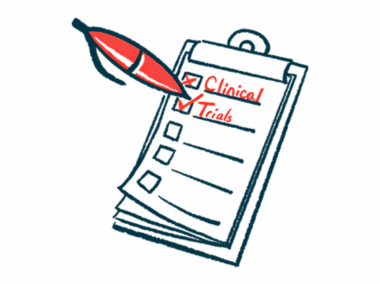Nipocalimab safely eases gMG symptoms in teens: Vibrance trial
All 7 adolescents enrolled to date responded poorly to standard care
Written by |

Johnson & Johnson’s nipocalimab appears to be safe and to ease symptoms of generalized myasthenia gravis (gMG) in adolescents with antibodies against the acetylcholine receptor, the most common type of MG-causing antibody, according to six-month data from an open-label clinical trial.
The Phase 2/3 Vibrance-MG study (NCT05265273) is testing nipocalimab’s safety and tolerability, and how well it works to ease disease severity in children and adolescents, ages 2-17, whose symptoms are not well controlled despite stable standard-of-care treatment.
Data came from seven adolescents (six girls and one boy), with a mean age of 14.1, enrolled in the study, which still may be recruiting up to 12 patients at more than a dozen sites in the U.S., Japan, Poland, and the Netherlands. In the U.S., children must be at least 8 years old to be eligible.
Nipocalimab is designed to lower IgG antibody levels in the bloodstream
“It is encouraging to see these positive results as there are currently no approved advanced treatment options for this adolescent population in the United States,” Jonathan Strober, MD, director of clinical services for child neurology at Benioff Children’s Hospital, part of the University of California, San Francisco, said in a company press release.
Data were in the oral presentation “Safety and effectiveness of nipocalimab in adolescent participants in the open label Phase 2/3 Vibrance-MG clinical study,” given at this year’s American Association of Neuromuscular & Electrodiagnostic Medicine (AANEM) annual meeting, held Oct. 15-18 in Savannah, Georgia.
“The Vibrance-MG data presented … further enrich the growing clinical profile of investigational nipocalimab, showcasing its promise for adolescents with [gMG] who often experience severe symptoms and need new treatment options,” Sindhu Ramchandren, MD, executive medical director of neuroscience at Johnson & Johnson Innovative Medicine, said in an emailed statement to Myasthenia Gravis News.
Like other types of MG, gMG is caused by misguided autoantibodies that disrupt communication between nerves and muscles, leading to muscle weakness in various parts of the body, such as the arms, legs, and face. In severe cases, this weakness — a hallmark disease symptom — can cause difficulty swallowing and breathing.
Nipocalimab is an antibody that’s designed to lower the levels of circulating antibodies of the immunoglobulin G (IgG) class, including the autoantibodies that cause gMG, thereby easing disease severity.
In Vibrance-MG, all enrolled are receiving nipocalimab as an intravenous (into-the-vein) infusion at a dose of 15 mg/kg once every two weeks, after an initial 30 mg/kg loading dose, on top of standard care for up to 24 weeks (six months). Five of the seven adolescents evaluated had completed a full 24 weeks of treatment.
The study’s main goal is to assess the therapy’s ability to reduce IgG antibody levels in the bloodstream. Treatment with nipocalimab plus standard of care met this goal, with total IgG levels falling by a mean of 69% over those six months.
“Results show a significant reduction in IgG of approximately 70% in adolescents and a clinical benefit that is consistent with the Vivacity-MG3 study in adults,” said Strober, who also directs Benioff Children’s muscular dystrophy clinic.
Benefits at six months of treatment noted by patients and clinicians
Treatment also led to a mean 2.4-point reduction in the MG Activities of Daily Living (MG-ADL) score, a patient-reported measure of how the disease impacts daily life activities, in which higher scores indicate more severe symptoms. Four patients achieved minimal symptom expression, with an MG-ADL score of zero or one by week 24.
Over the same time window, patients showed a mean 3.8-point reduction in the Quantitative MG (QMG) score, a clinician-rated measure of muscle weakness. Here, again, a higher score indicates more severe disease.
Moreover, “nipocalimab was well-tolerated; there were no serious adverse events and no discontinuations due to an adverse event,” researchers wrote in an abstract to the AANEM presentation published in the journal Muscle & Nerve (presentation No. 276).
Johnson & Johnson has filed applications in the U.S. and Europe requesting the approval of nipocalimab to treat gMG, but its clinical development also covers other indications.
“We are dedicated to creating innovative solutions for autoantibody-driven neurological diseases, such as gMG, with the goal of improving the lives of those affected by these conditions,” Ramchandren said.







Leave a comment
Fill in the required fields to post. Your email address will not be published.